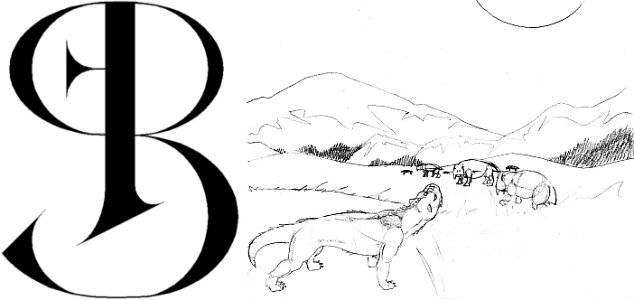
Xanadu is an island empire on the
Squawk world Peleg. The culture of Xanadu is modeled after asian countries such as China and Japan. This drawing was a sketch for a 3D Squawk game we started to develop set in Xanadu. The linear perspective and very limited use of atmospheric depth is more in the tradition of european art than asian art and the clash is akward.

This is a quick sketch for a
2D Squawk game we are beginning to develop. Vertical exaggeration, atmospheric perspective, and orthographic perspective (parallel lines look parallel in the image) give the scene the look of a Chinese ink painting, and lend themselves naturally to a 2D game engine.
The small garden shows how the game might be different from a painting. In a painting the left and right sides of the fence would be at an angle, making it difficult to sort out whether the fence should be drawn in front of or behind each character. In this design the sides of the fence are vertical to make sorting simpler.
This sketch was drawn over and around printed text, which I removed using the
GIMP's select-by-color tool, deselecting the parts I didn't want removed, growing the selection by one pixel, and clearing the selected area. If you look closely you can still see the holes where the text was.

This is another sketch for the Squawk 2D game. Four of the five intelligent species of Xanadu (Minotaur, Titan, Kobold, and Gargoyle), a theropod dinosaur ("lyndwyrm") and a sauropod ("behemoth") are shown in size comparison. The interior is shown with orthographic perspective typical of Japanese woodblock prints, and the exterior is shown in a simplified orthographic perspective like the garden above.

Here's a small wooden building with a different type of orthographic perspective, similar to the game Diablo. In a game, this image would be difficult to sort, so it would probably be broken down into parts which would be sorted seperately.

This tower was looking pretty good until I ran out of space at the top :-) The eight sides of the tower are inspired by Chinese pagodas, but also might represent the
eight elements of Xanadu's alchemy tradition: water, wood, earth, metal, fire, lightning, air and shadow, or the eight legs of the giant spiders which produce bulletproof spider-silk, the empire's most important product.

I tried to create a more alien style of architecture in this drawing. It's one of my favorites.
 The intelligent species of the Squawk role-playing game are named after creatures from mythology. Squawk Elves are carnivorous flightless birds with long, powerful arms. Elves can catch prey with the retractable talons of their hands and feet, and break bones with their powerful beak, but they are also intelligent hunters who employ strategy and weapons. The elves were once the masters of a multi-planet dynasty based around electrical technology, but now most elves live in small nomadic bands or minority communities among the other intelligent species.
The intelligent species of the Squawk role-playing game are named after creatures from mythology. Squawk Elves are carnivorous flightless birds with long, powerful arms. Elves can catch prey with the retractable talons of their hands and feet, and break bones with their powerful beak, but they are also intelligent hunters who employ strategy and weapons. The elves were once the masters of a multi-planet dynasty based around electrical technology, but now most elves live in small nomadic bands or minority communities among the other intelligent species. My original concept for the elves was a neckless creature with absurdly massive claws. All four feed would be equipped like the right foot in this drawing. This would make them the "Wolverine" or "Freddy Kruger" of the Squawk universe. (Most of the intelligent species seem to be competing for this position, but the current champions seem to be Gryphons.)
My original concept for the elves was a neckless creature with absurdly massive claws. All four feed would be equipped like the right foot in this drawing. This would make them the "Wolverine" or "Freddy Kruger" of the Squawk universe. (Most of the intelligent species seem to be competing for this position, but the current champions seem to be Gryphons.) My brother Ulrich developed this alternate visualization of Elf anatomy. In this version, the elf stil has a powerful neck, round body, and similarly-proportioned arms and legs with sharp claws, but the length of the claws is less extreme (but more consistent than my drawings) and the neck is long enough for the head to look around.
My brother Ulrich developed this alternate visualization of Elf anatomy. In this version, the elf stil has a powerful neck, round body, and similarly-proportioned arms and legs with sharp claws, but the length of the claws is less extreme (but more consistent than my drawings) and the neck is long enough for the head to look around.







































